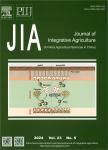Molecular Cloning of Myostatin Partial cDNA of Beijing Duck and Its Expression in Breast Muscle
Molecular Cloning of Myostatin Partial cDNA of Beijing Duck and Its Expression in Breast Muscle作者机构:State Key Laboratory of Animal Nutrition Institute of Animal Science Chinese Academy of Agricultural Sciences Beijing 100094 P.RChina
出 版 物:《Agricultural Sciences in China》 (中国农业科学(英文版))
年 卷 期:2006年第5卷第6期
页 面:468-472页
学科分类:0710[理学-生物学] 0905[农学-畜牧学] 09[农学] 0901[农学-作物学] 0902[农学-园艺学]
基 金:The experiment was sponsored by Academic Science Foundation of the Chinese Academy of Agricultural Sciences(2006) the Special Research Program of China(waterfowl healthy feeding technology)
主 题:Beijing duck myostatin cloning and sequence analysis expression
摘 要:In this experiment, 500 bp cDNA of myostatin gene was cloned from a Beijing duck's breast, The duck myostatin gene was found to have 98, 96, 95, 88, and 87% sequence similarity at the cDNA level with domestic goose, chicken, domestic pigeon, human, and pig, respectively. The predicted amino acid sequence has an overall similarity with a comparable region of turkey 99%, domestic goose 98%, and chicken 99%. Conserved domains of deduced amino acids showed that it belonged to the TGF-beta family. Myostatin expression in breast muscle was higher at 28, 35, and 42 days than at 7, 14, and 21 days. The pattern of myostatin expression was closely parallel to the trend of breast muscle growth, suggesting that myostatin might play an important role in breast muscle development. It was possible to postulate that myostatin may be a major determinant of muscle mass in breast muscle, as shown in other species.



